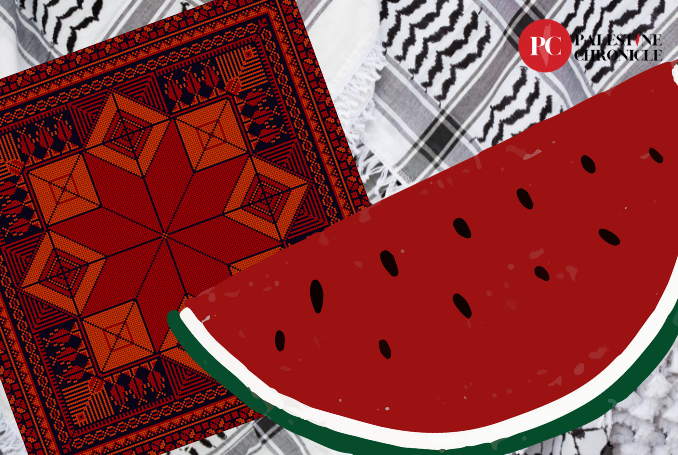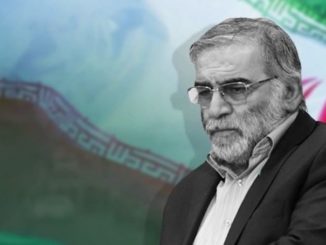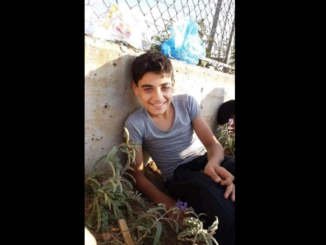
By Ramzy Baroud & Romana Rubeo
Some symbols, although employed even before the beginning of the Al-Aqsa Flood Operation, became far more popular after October 7.
Those who admonish Palestinian Resistance, armed or otherwise, have little understanding of the psychological ramifications of resistance, such as a sense of collective empowerment, honor and hope.
But resistance is not just a rifle, a rocket launcher. The latter are but one manifestation in resistance and, if not backed by strong popular support, they hardly have much impact.
Indeed, all forms of sustainable resistance have to be rooted in culture, which helps it generate new meanings, over time.
In the case of the Palestinian struggle, the concept of resistance is multifaceted and strongly embedded in the collective psyche of generations of Palestinians, which allows it to surpass the ideological and political confines of factions and political groups.
Though the symbols of this resistance – for example, the kuffiyeh, the flag, the map and the key – are part of this generation of meanings, they are mere signifiers of ideas, beliefs and values that are truly profound.
No matter how hard Israel has tried to discredit, ban or recounter these symbols, it has failed and will continue to fail.
In the early 2000s, for example, Israeli fashion designers created what was supposed to be Israeli kuffiyehs. The Israeli scarves, from a distance, looked similar to the Palestinian traditional scarves, except that they were mostly blue. At a closer look, one would be able to decipher that the Israeli replica of the Palestinian national symbol is often a clever manipulation of the Star of David.
This could easily be classified under the banner of cultural appropriation. In actuality, it is far more complex.
Palestinians did not invent the kuffiyeh, or hatta, one of the most common neck or even head scarves throughout the Middle East. But, what they did is that they took ownership of the kuffiyeh, giving it deeper meanings – dissent, revolution, unity.
The kuffiyeh’s prominence was partly compelled by Israel’s own actions and restrictions.
After occupying the remainder of historic Palestine, namely East Jerusalem, the West Bank and Gaza, Israel immediately banned the Palestinian flag. That ban was part of a much larger restrictive campaign aimed at preventing Palestinians from expressing their political aspirations, even if symbolic.
What the Israeli military administration could not prevent was the use of the kuffiyeh, which was a staple in every Palestinian home. Subsequently, the kuffiyeh quickly became the new symbol of Palestinian nationhood and resistance, at times even replacing the now banned flag.
The history of the kuffiyeh goes back to many years before the Nakba, the ethnic cleansing of historic Palestine by Zionist militias in 1947-48.
In fact, if one is to examine any revolt in the modern history of Palestine, from the 1936-39 Palestinian strike and rebellion to Palestinian resistance during the Nakba, to the Fedayeen movement in the early 1950s, all the way until the present, the kuffiyeh has featured prominently as arguably the most important Palestinian symbol.
Yet, the real rise of the kuffiyeh as the symbol of global solidarity with Palestine and the Palestinians did not become a truly international phenomenon until the First Intifada in 1987. It was then that the world watched in awe an empowered generation only armed with rocks facing the well-equipped Israeli army.
Two Types of Symbols
It is worth noting that, when we talk about the ‘symbolism’ of Palestinian cultural symbols, and to counter Israeli cultural symbols, we refer to two types of symbols: one that is laden with intangible, although quintessential representations – for example, the watermelon – and another with tangible and consequential representations – for example, the Al-Aqsa Mosque.
The Al-Aqsa Mosque is a symbol of Palestinian spirituality, history, nationalism, and also an actual physical structure that is located in an occupied Palestinian city, Al-Quds, East Jerusalem. For many years, Israel has perceived the Mosque with alarm, countering the Palestinian claim by alleging that, beneath Al-Aqsa, there lie the ruins of the Jewish Temple, whose resurrection is critical for Jewish spirituality and purification.
Therefore, Al-Aqsa cannot be considered a mere symbol, serving the role of a political representation. To the contrary, it has grown in terms of imports to carry a much more profound meaning in the Palestinian struggle. It would not be an exaggeration to argue that the survival of Al-Aqsa is now directly linked to the very survival of the Palestinian people as a nation.
According to renowned Swiss linguist Fernand de Saussure, every sign or symbol is composed of a ‘signifier’, meaning the form that the sign takes, and the ‘signified’, the concept that it represents.
For example, although a map is commonly defined as the geographic representation of an area or a territory merely showing physical features and certain characteristics of the place, it can take on a different ‘signified’ when the territory or land in question is an occupied one, as Palestine is. Therefore, the physical representation of Palestine’s borders became, with time, a powerful symbol, reflecting the injustice inflicted upon the Palestinian people throughout history.
The same process was applied to the keys belonging to those very refugees, the victims of Israel’s ethnic cleansing of Palestine. The only difference is that, while the villages existed, then ceased to exist, the key existed as a physical object, before and after the Nakba. The house and the door are, perhaps, gone, but there is a physical key that still, symbolically, unlocks the dichotomy of the past, with the hope of, one day, restoring the door and the house as well.
In view of this, the segment of land stretching from the Jordan River to the Mediterranean Sea, ceased to be just sand, water, grass and stones, and became the representation of something else entirely.
It must be denoted that the slogan ‘From the River to the Sea’ neither references actual topography nor politics. It is based on the understanding that a disruptive historical event has wrought a great deal of injustice, pain and hurt to historic Palestine. Confronting this injustice cannot be segmented, and it must take place through a wholesome process that would allow the land but, more importantly, the native inhabitants of that land, to restore their dignity, rights and freedom.
Watermelons and Red Triangles
Some symbols, although employed even before the beginning of the Al-Aqsa Flood Operation, became far more popular after October 7. The watermelon, for example, has been used, time and again, throughout Palestine’s modern history, specifically when Israel banned the ownership or the displaying of the Palestinian flag. The fruit itself, aside from being a symbol of the richness of the land of Palestine, also features the same colors of the flag: black, red, white and green.
Another related symbol is the red triangle. A small red triangle began appearing as a functional tool in videos produced by the Al-Qassam Brigades, merely to point at a specific Israeli military target before it was struck by a Yassin 105 or an RPJ shell, or any other.
With time, however, the red triangle began acquiring a new meaning, regardless of whether it was intended by those who designed the Qassam videos, or not.
The red triangle, as a symbol, was connected, by some, to the Palestinian flag, particularly to the red triangle on the left, situated over the white color, between black and green. In truth, the origins of the small, red triangle do not matter. Like other Palestinian symbols, it, too, has generative power to accumulate new meanings over time.
Culture and Counter-culture
Like the ‘Israeli kuffiyeh’, Israel has tried to counter Palestinian culture. They did so mostly by devising laws to prohibit Palestinians from communicating or embracing their cultural symbols.
Another tactic that Israel used was claiming Palestinian symbols as if their own. This is quite common in clothes, food and music. When Israel hosted the Miss Universe Beauty Pageant, in 2021, contestants were taken to the Arab Bedouin city of Rahat. Being obviously unaware that Bedouin culture, with its embroidered clothes, food, music and numerous cultural manifestations, is a uniquely Palestinian Arab culture, beauty pageants took to social media to express their excitement about being part of “a day in the life of a Bedouin”, with the hashtag #visit_israel.
Such episodes may highlight the degree of deception on the part of Israel, but also expose to a large extent Israel’s feeling of cultural inferiority. A quick examination of Israeli symbols, whether it is the flag with the star of David, the Lion of Judah or national war songs, such as Harbu Darbu, seem to be largely extracted from biblical references, and religious heroics that have existed even prior to the existence of Israel itself.
And, while Palestinian symbols reflect the desire of Palestinians to return to the land of their ancestors, and to reclaim the rights and justice which they have been long denied, Israeli symbols seem to merely lay claims – ancient, religious, unverifiable. If this reflects anything, it tells us that, despite nearly a century of Zionist colonialism, and 75 years of official existence as a state, Israel has failed to connect to the land of Palestine, to the cultures of the Middle East, let alone carve for itself a place in the yet to be written history of the region, a history that will surely be written by the native inhabitants of that land, the Palestinian people.
– Dr. Ramzy Baroud is a journalist, author and the Editor of The Palestine Chronicle. He is the author of six books. His latest book, co-edited with Ilan Pappé, is ‘Our Vision for Liberation: Engaged Palestinian Leaders and Intellectuals Speak Out’. His other books include ‘My Father was a Freedom Fighter’ and ‘The Last Earth’. Baroud is a Non-resident Senior Research Fellow at the Center for Islam and Global Affairs (CIGA). His website is www.ramzybaroud.net
– Romana Rubeo is an Italian writer and the managing editor of The Palestine Chronicle. Her articles appeared in many online newspapers and academic journals. She holds a Master’s Degree in Foreign Languages and Literature and specializes in audio-visual and journalism translation.








That Israel has failed to connect to the land is obvious from the way the IDF and the settlers in the West Bank regularly tear up olive trees. From the reading of the Bible, one might assume that Jews would feel some affinity to the olive tree, but Israel has substituted the Pine tree, one of the European trees. I suppose we should be grateful they didn’t substitute the ash or the oak, both of which were sacred to the Germanic and Celtic people …